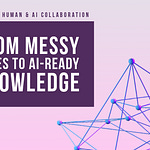In this video, I demonstrate how to build a practical prompt library using Twos, a free organizational tool with an intuitive structure. While Twos might not be ideal for large corporations, it perfectly illustrates how structure enhances prompt libraries—principles you can apply to any system … not just prompts.
Hint: This is the first step to understanding how to structure content for AI knowledge bases … which is where my PromptOps course is going.
This video tutorial complements lesson 10 on building a FAIR prompt library.
Twos stands out as an exceptional learning tool because of its straightforward organizational philosophy. Unlike complex tools that overwhelm users with features, Twos operates on a remarkably simple concept: everything is either a "thing," a list, or a sublist.
The power of Twos lies in how these simple building blocks can represent complex relationships—vertical hierarchies through lists and sublists, horizontal connections through tags, and most importantly, the ability to reuse "things" across multiple locations.
This reuse feature is particularly valuable for prompt libraries, as it teaches the essential concept that prompt components should be modular, consistent, and maintainable across an entire system.
The video shows my implementation of a prompt library for my "Writing for AI" class, where student groups created prompts in three categories: creative writing, career, and social media marketing. I demonstrate how Twos organizes content through:
Vertical organization: Lists and sublists create a clear hierarchy
Horizontal organization: Tags allow cross-referencing across categories
Reusable components: Prompt blocks can exist in multiple places simultaneously
The key advantage of this system is that prompt blocks (like role blocks, task blocks, etc.) can be reused across different prompts while maintaining consistency. When you update a block in one location, it updates everywhere.
I also show how easy it is to search by tags to find specific types of prompt blocks, which helps maintain consistency across your entire library.
This approach creates an expandable system where new categories, subcategories, and prompts can be added over time, and existing prompts can be refined as AI models evolve.
For anyone interested in trying Twos, the video includes a brief look at the interface basics to help you get started with this powerful yet simple organizational tool.











